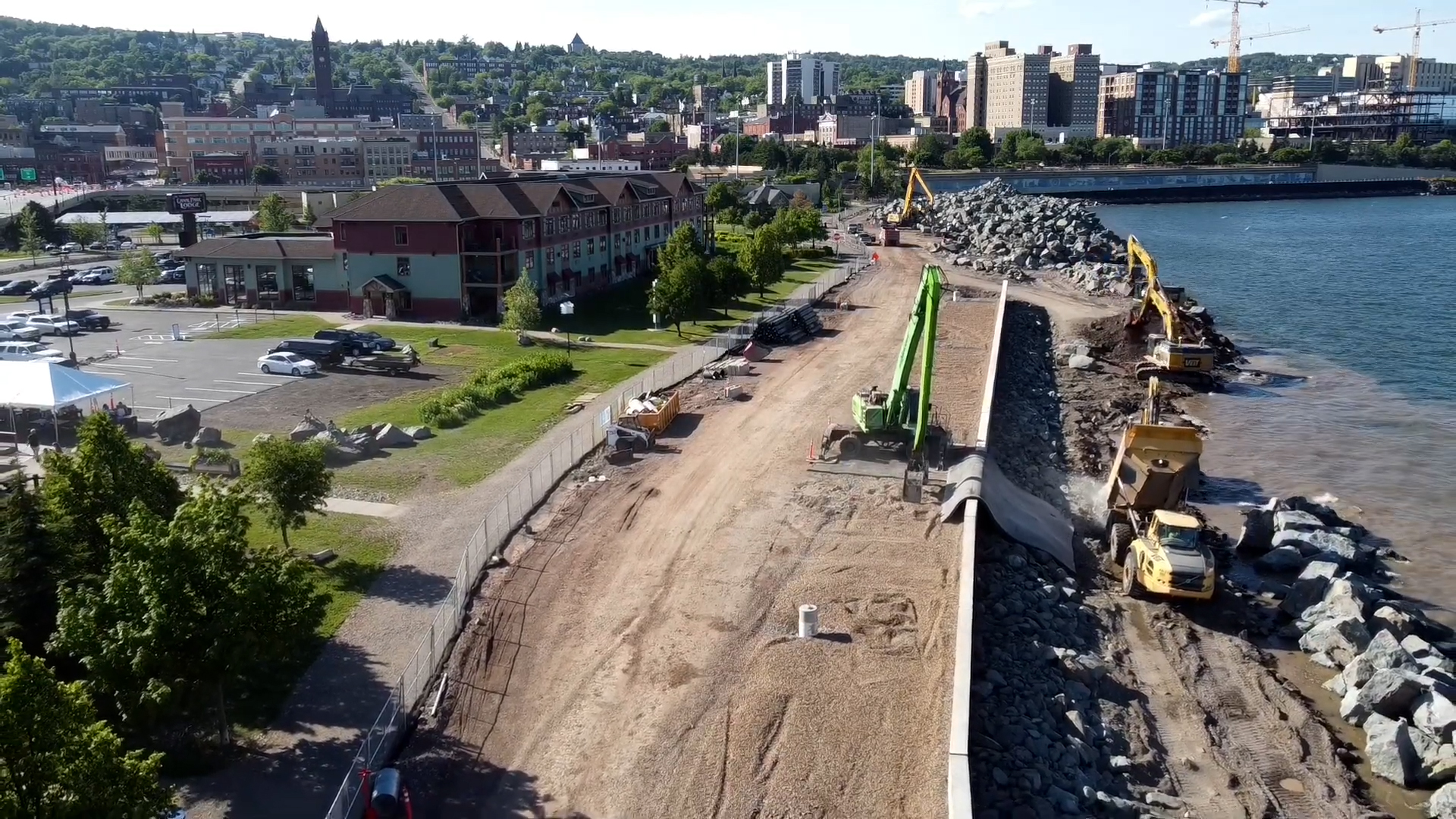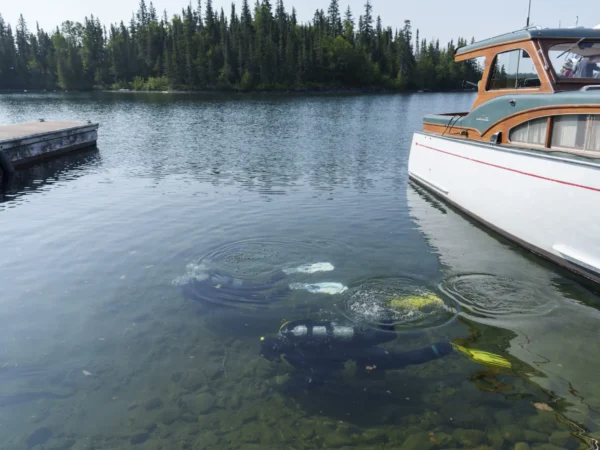
Big waves pounding Midwestern city waterfronts are common images around the Great Lakes, which means communities are dealing with the impacts of storms that are increasing in frequency and severity.
One of those cities has been making strides in improving its resiliency while preserving its culture – Duluth, Minnesota.
Great Lakes Now took you to see some of the city’s efforts earlier this year, in particular the rebuilding of the Lakewalk. Now, months later, we checked back with Duluth mayor Emily Larson to see whether the city’s infrastructure changes have continued to hold up in the wake of some fierce November storms.
Watch the interview here:
Or read the transcript of the interview with the mayor below. The following interview was edited for length and clarity.
Great Lakes Now: Can you describe for me the waterfront improvements in your Lake Superior city?
Emily Larson: The project is awesome. It has held up beautifully. We are, of course, kind of in the beginning stages of a winter season here. We have not had the challenge of the first huge blizzard that we would normally have had by now. But we have had a lot of challenging weather come our way and it’s holding up beautifully. It is gorgeous, it is very popular. People are so happy with it, and I’m so proud of this community for knowing and choosing this path for the preservation of access and the inclusion of resiliency.
GLN: Yeah, you mentioned just now there have been some storms. Were those the gales of November or what did you kind of see in terms of weather in Duluth this year?
EL: Yeah, well, do we really know anymore? Minnesota right now is, today, the day that we are recording this, we are actually expecting a December tornado in the state. And this kind of weather pattern – It’s actually very interesting to talk to you on a day like today. The weather we are seeing today is completely out of line and out of sync with what we see, and I do believe that that is climate change in action. Typically, we would have – we’ve had one big snowfall and a windstorm that went with that, but nothing as catastrophic as we would typically see. But we did do really well through some fall storms and some of those gales of November when those winds get up to just below, some of those were just below hurricane force. But I will say every time we have had a big storm, afterwards when it’s safe, I rushed down to check and see how it’s doing. And there it is. It’s just standing. It’s just steady and gorgeous and doing its job.
The initial view and experience we had with that project was really about reclamation of damage and reclaiming the space. It became about much more. And we talked about that previously, but it really became about continuing to prioritize public access, free access to the Great Lakes, which is really special and important. It was about preserving the public infrastructure that is all along all of that Lakewalk, whether it’s sewer stormwater infrastructure like streets, and supporting the economic development and private investment that happens around that whole area.
GLN: You mentioned families and the public, so can you tell me a bit more about how Duluth residents have responded to these changes?
EL: Yeah, they have been wonderfully on board. A project like this is not inexpensive. We’ve talked about the price tags before. They are very complicated to fund because it isn’t just a city’s responsibility. We put in money, and we put in some investment. But you’re talking about the Army Corps of Engineers, the Department of Natural Resources, the Minnesota Pollution Control Agency. Bonding from the state legislature is very complicated, and the overall price tag is really, really high. And often when that happens in government, people have feelings about how we spend money and what that looks like and whether something’s worth it or not.
And here in Duluth, our public never had significant resistance to that. There would be some outliers around, maybe we should just completely abandon it, which is not the intersection we’re at conversationally. But really, for the most part, it was – I wouldn’t say it was a slam dunk no-brainer, but it was like, that’s our identity. And if we can preserve the access and identity and economic development and do so in a way that is really climate forward, that’s the lane for our community and people were completely on board. We actually did a dedicated property tax increase just to go to the Lakewalk restoration and literally zero pushback on that for the public.
Our public is very engaged here. They show up to every public meeting and they are very clear in what their expectations and concerns are.
GLN: So is the Lakewalk finished for now, or are there still improvements that the city is working on or looking to make?
EL: We’re always making improvements. The Lakewalk itself is about a 7-mile stretch, really a continuous stretch around the lake, with some exceptions in terms of geography and erosion and things like that. But it finishes at a place called Brighton Beach, which is a gorgeous, really important park, and itself is about a mile-long park. And so we are actually redoing that entire park because of climate change, climate adaptation, significant erosion.
And again, it has tremendous support. There’s not been any questions or concerns that we do the work we need to be doing here. I think part of it is we’ve really spoken clearly and done our research around why building an adaptation makes sense and why that’s a smart investment, and the community has gone there with us, so we really appreciate their trust.
GLN: Kind of along those lines, how does your office kind of approach the idea of stewardship of the Great Lakes?
EL: So in terms of how we consider stewardship with the Great Lakes, I do participate in some national and international groups – international being with Canada – who are focused on the Great Lakes, that are focused on different areas. I’m now also on a National League of Cities federal policy committee around environment, energy, natural resources. And then we also, it’s almost like we specifically staff the Great Lakes in some ways because we do have a sustainability coordinator, an officer with the city of Duluth that is tracking all things that relate to sustainability and renewable energy and lake temperature, things like that. And then also our parks maintenance and facilities team is the one that led the Lakewalk restoration.
And so we see our stewardship of the lake being really a core part of our mission and vision as a city. It’s a beautiful trademark of who we are, this lake, but it is also a very palpable spiritual experience to live near it. And people have a deeply personal connection to water, what it means, how it feels, how you use it and access to it. So for us, stewardship is non-negotiable. It’s what we do.
Catch more news on Great Lakes Now:
Soil hauled from Detroit park as part of storm water project
Coastal Concerns: Communities lack skilled staff and funding to tackle erosion and flooding
Featured image: Construction on the new, more robust Duluth Lakewalk. (Photo courtesy of Joseph Karow)




